|
Oenanthe pileata (Capped wheatear)
Hoëveldskaapwagter [Afrikaans]; Inkotyeni, Isixaxabesha (these terms also
applied to Buff-steaked chat) [Xhosa]; iSangwili [Zulu]; Kazinganzwi
[Kwangali]; Thoromeli (also applied to Ant-eating chat) [South Sotho];
Ntidi [Tswana]; aardtapuit [Dutch]; Traquet du Cap [French]; Erdschmätzer
[German]; Chasco-de-barrete [Portuguese]
Life
> Eukaryotes >
Opisthokonta
> Metazoa (animals) >
Bilateria >
Deuterostomia > Chordata >
Craniata > Vertebrata (vertebrates) > Gnathostomata (jawed
vertebrates) > Teleostomi (teleost fish) > Osteichthyes (bony fish) > Class:
Sarcopterygii (lobe-finned
fish) > Stegocephalia (terrestrial
vertebrates) > Tetrapoda
(four-legged vertebrates) > Reptiliomorpha > Amniota >
Reptilia (reptiles) >
Romeriida > Diapsida > Archosauromorpha > Archosauria >
Dinosauria
(dinosaurs) > Saurischia > Theropoda (bipedal predatory dinosaurs) >
Coelurosauria > Maniraptora > Aves
(birds) > Order: Passeriformes
> Family: Muscicapidae > Genus: Oenanthe
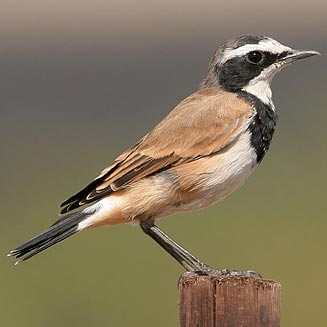 |
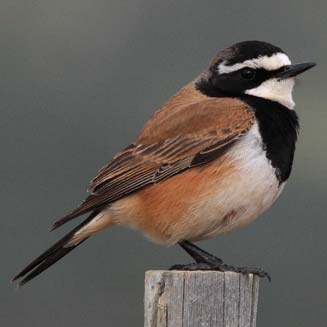 |
|
Capped wheatear, Philadelphia, South Africa. [photo
Trevor Hardaker ©] |
Capped wheatear, near Vanrhynsdorp, Northern
Cape, South Africa. [photo
Duncan Robertson ©]. |
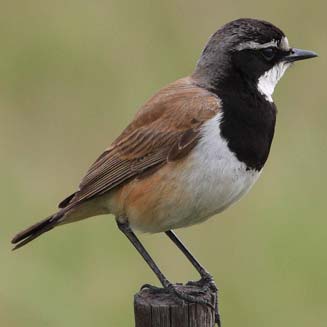 |
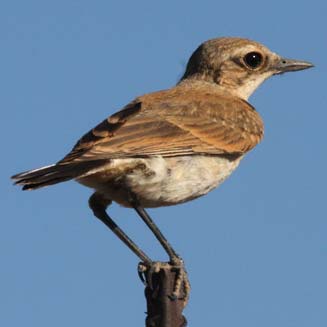 |
|
Capped wheatear, Western Cape, South Africa. [photo
Duncan Robertson
©] |
.Capped wheatear juvenile, Melton Wold farm,
Northern Cape, South Africa. [photo
Duncan Robertson ©]. |
Distribution and habitat
Occurs in Africa south of the Sahel, from Kenya, southern
DRC and Tanzania through Angola and Zambia to southern Africa. Here it is common
across most of the region, excluding southern Mozambique and south-eastern South
Africa, generally preferring dry grassy plains with patches of bare ground,
semi-arid shrubland, cattle pens, fallow fields and recently harvested cropland.
|
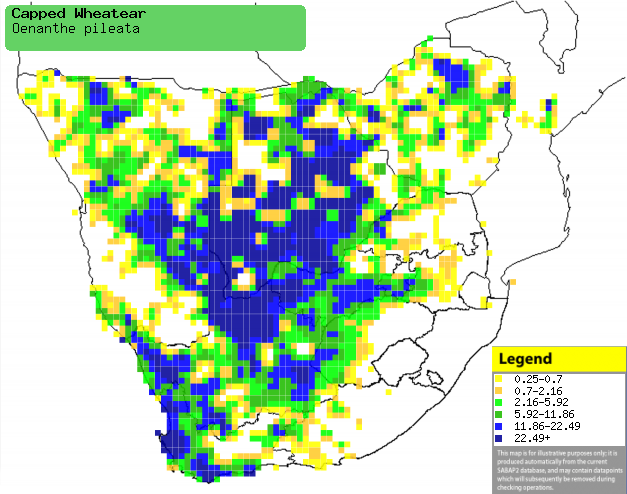 |
|
Distribution of Capped wheatear in southern
Africa, based on statistical smoothing of the records from first SA Bird
Atlas Project (©
Animal Demography unit, University of
Cape Town; smoothing by Birgit Erni and Francesca Little). Colours range
from dark blue (most common) through to yellow (least common).
See here for the latest distribution
from the SABAP2. |
Predators and parasites
It has been recorded as prey of the Black-footed cat (Felis
nigripes).
Movements and migrations
Complex and not well known, as it is thought be
resident in some areas and a breeding migrant in others. Generally,
it is thought to breed in the higher rainfall areas of its
distribution from about July-November, after which it migrates to
more arid regions such as Namibia, the Kalahari Desert and the Karoo.
Food
It mainly eats insects (especially ants), supplemented with
other invertebrates, fruit and seeds. It does most of its foraging from a perch,
pouncing on prey on the ground or sometimes chasing and stabbing them. The following food items have been recorded
in its diet:
- Invertebrates
- Fruit
- Seeds
Breeding
- The nest is a cup built of leaves, grass and rootlets and lined with hair
feathers and other fine material. It is typically placed up to around one
metre below ground in a rodent burrow, although it has been recorded to use
old metal railway sleepers as nest sites.
- Egg-laying season is from June-October, peaking from August-September.
- It lays 2-4, rarely 5 pale bluish or greenish white eggs.
Threats
Not threatened, in fact it has adapted to well to the
introduction of cultivation.
References
-
Hockey PAR, Dean WRJ and Ryan PG 2005. Roberts
- Birds of southern Africa, VIIth ed. The Trustees of the John Voelcker
Bird Book Fund, Cape Town.
|
